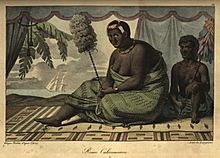Kaʻahumanu facts for kids
Quick facts for kids Kaʻahumanu |
|||||
|---|---|---|---|---|---|

Queen Ka'ahumanu of Hawaii
|
|||||
| Queen consort of Hawaii | |||||
| Tenure | 1795–1819 | ||||
| Kuhina Nui of the Hawaiian Islands | |||||
| Tenure | May 20, 1819 – June 5, 1832 | ||||
| Predecessor | Office Established | ||||
| Successor | Kaʻahumanu II | ||||
| Born | March 17, 1768 Puu Kauiki, Hāna, Maui |
||||
| Died | June 5, 1832 (aged 64) Mānoa Valley, near Honolulu, Oahu |
||||
| Burial | Royal Mausoleum at Mauna ʻAla | ||||
| Spouse | Kamehameha I Kaumualiʻi Kealiʻiahonui |
||||
| Issue | Kamehameha II (hānai) David Kamehameha (hānai) Keʻelikōlani (hānai) Theresa Owana Kaheiheimālie Rives (hānai) Virginia Kahoa Kaʻahumanu Rives (hānai) |
||||
|
|||||
| House | Kamehameha Kekaulike |
||||
| Father | Keʻeaumoku II Pāpaʻiahiahi | ||||
| Mother | Nāmāhāna-i-Kaleleokalani | ||||
Kaʻahumanu (March 17, 1768 – June 5, 1832) was a powerful leader in the Kingdom of Hawaiʻi. She was the favorite wife of King Kamehameha I. After his death, she became a co-ruler, known as Kuhina Nui. This role was like a regent or prime minister. She held great power during the reigns of Kamehameha I's first two successors.
Contents
Early Life of Kaʻahumanu
Kaʻahumanu was born on March 17, 1768. Her birthplace was a cave called Puu Kauiki in Hāna, on the island of Maui. Today, the Kaʻahumanu Society celebrates her birthday.
Her father was Keeaumoku Pāpaiahiahi, a noble, or aliʻi. He was fleeing from a rival at the time. Her mother was Nāmāhānaikaleleokalani. Kaʻahumanu had several siblings. These included Governor John Adams Kuakini and Queen Kalākua Kaheiheimālie.
When Kaʻahumanu was thirteen, her father arranged for her to marry Kamehameha I. Her father was an important advisor to the king. Kamehameha had many wives, but Kaʻahumanu became his favorite. She encouraged him in his efforts to unite all the Hawaiian islands.
Kaʻahumanu as Queen Regent
Kaʻahumanu was King Kamehameha I's most powerful wife. When he died on May 8, 1819, Kaʻahumanu announced his wish. He wanted her to share power with his 22-year-old son, Liholiho. Liholiho became King Kamehameha II.
The king's advisors agreed. They created a new position for Kaʻahumanu called Kuhina Nui. This role was similar to a co-ruler or a modern-day prime minister. Her power grew steadily. She ruled as Queen Regent during the reigns of both Kamehameha II and Kauikeaouli. Kauikeaouli later became King Kamehameha III.
Kaʻahumanu was a strong supporter of Hawaiian women's rights. She challenged old traditions. One important event was called the 'Ai Noa (free eating). Kaʻahumanu and another queen, Keōpūolani, ate at the same table as the young king. This broke a major traditional rule, or kapu. Breaking this rule was once forbidden. But by doing this, Kaʻahumanu showed that the old rules were changing. This event helped end the old kapu system.
Uniting the Islands with Kaumualiʻi
The islands of Kauaʻi and Niʻihau were never conquered by force. After years of talks, their king, Kaumualiʻi, agreed to join Kamehameha's kingdom peacefully. This happened in 1810.
When Kamehameha I died, the new King Kamehameha II and Kaʻahumanu worried. They feared Kauaʻi might try to leave the kingdom. To keep the islands united, Kaʻahumanu married Kaumualiʻi in 1821. This marriage helped strengthen the union. After Kaumualiʻi died in 1824, she married his son, Kealiʻiahonui.
Embracing Christianity
In April 1824, Kaʻahumanu became a Protestant Christian. She encouraged her people to also become baptized. That same year, she helped create Hawaiʻi's first written laws. These laws were based on Christian values and the Ten Commandments.
Kaʻahumanu was baptized on December 5, 1825. This happened at the place where Kawaiahaʻo Church stands today. She took the Christian name "Elizabeth".
She also made decisions about other religions. In 1827, she asked the first Catholic missionaries to leave. In 1830, she signed a law that stopped Catholic teachings. It also said that anyone who broke this law could be sent away from the islands.
In 1832, Kaʻahumanu visited Maui. She saw a church service at the site of what is now Kaʻahumanu Church. She asked the missionaries to name the permanent church after her. This request was honored later, in 1876.
Banning Hula
As the regent of Hawaiʻi, Kaʻahumanu used her power to enforce Christian policies. In 1830, she banned the traditional Hawaiian dance, hula.
After her death in 1832, some chiefs did not follow this ban. King Kamehameha III was one of them. However, hula was not openly celebrated again until 1886. This was during the reign of King Kalakaua. He famously said, "Hula is the language of the heart and therefore the heartbeat of the Hawaiian people." Kaʻahumanu's ban had a lasting effect on how hula was viewed.
Establishing American Relations
Kaʻahumanu and King Kamehameha III worked together. They negotiated the first treaty between the Kingdom of Hawaiʻi and the United States. This happened in 1826, during President John Quincy Adams's time.
The treaty helped Hawaiians pay off debts to American traders. They paid with $150,000 worth of sandalwood. This helped Kaʻahumanu gain support from chiefs who owed money. The treaty also allowed Americans to trade freely in all Hawaiian ports. Americans could also use Hawaiian courts and be protected by Hawaiian laws.
Later Life and Death
In 1827, Kaʻahumanu's health began to decline. During her illness, missionaries printed the first Hawaiian New Testament. It was bound in red leather with her name in gold. She kept it with her until she died.
Kaʻahumanu passed away on June 5, 1832. She died from an intestinal illness in the Mānoa Valley near Honolulu. Her funeral was held at Kawaiahaʻo Church. This church is sometimes called the Westminster Abbey of Hawaiʻi. She was first buried at ʻIolani Palace grounds. Later, her remains were moved to the Royal Mausoleum.
See also
 In Spanish: Ka'ahumanu para niños
In Spanish: Ka'ahumanu para niños

